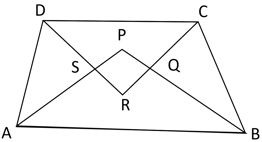NCERT Solutions for Chapter: Quadrilaterals, Exercise 1: Exercise
NCERT Mathematics Solutions for Exercise - NCERT Solutions for Chapter: Quadrilaterals, Exercise 1: Exercise
Attempt the free practice questions on Chapter 8: Quadrilaterals, Exercise 1: Exercise with hints and solutions to strengthen your understanding. NCERT Exemplar Mathematics - Class 9 solutions are prepared by Experienced Embibe Experts.
Questions from NCERT Solutions for Chapter: Quadrilaterals, Exercise 1: Exercise with Hints & Solutions
If bisectors of and of a quadrilateral intersect each other at bisectors of and at bisectors of and meet at and bisectors of and meet at , then is a

If and are two parallel lines, then the bisectors of the angles and form
The figure obtained by joining the mid-points of the sides of a rhombus, taken in order, is
and are the midpoints of the sides and of and is any point on side . is joined to . If and are the midpoints of and respectively, then is
The figure formed by joining the mid-points of the sides of a quadrilateral , taken in order, is a square only, if
The diagonals and of a parallelogram intersect each other at the point , if and then is equal to
Which of the following is not true for a parallelogram?
and are the midpoints of the sides and respectively of . is produced to . To prove that is equal and parallel to , we need additional information which is
